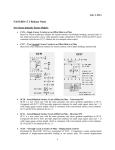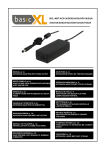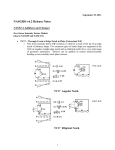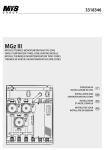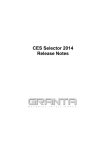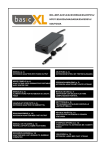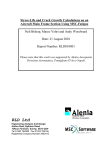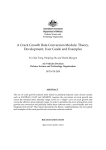Download NASGRO v6.1 Release Notes
Transcript
August 3, 2010
NASGRO v6.1 Release Notes
NASFLA Additions and Changes
•
•
•
Crack case TC16 (through crack in a curved stiffened panel) was enhanced to account for
a 2-bay crack with a broken stiffener (for both the Swift and Chen-Schijve bulge factor
models). TC16 now also allows the use of the Swift bulge factor for 1-bay cracks. (Also
in NASSIF and NASCCS)
A capability to input separate stress gradients for tension and compression loads was
implemented for the following weight function cases:
• Univariant: CC08, CC11, SC17, SC18, TC11, TC12, TC13, EC02, and EC05
• Bivariant: CC09, CC10, CC12, SC19, and EC04
This new feature is documented in Appendix C of the v6.1 user’s manual (Section C9.1B,
page C-89) and is illustrated in the figure below.
The compounding features (in both NASFLA and NASSIF) have been revamped and
enhanced and now provide much more flexibility and options:
• Compounding capabilities are now available for all through cracks, all corner
cracks and all 1-D/2-D surface cracks (44 crack cases in total) and can be
activated by checking a box on the “Geometry” GUI screen for each crack case.
Compounding tables can then be entered via the “Geom Tables” GUI screen.
• Implemented capability to specify multiple compounding tables for each stress
component (S0, S1, etc.)
• A different user's normalizing dimension and interpolation scheme can be
specified for each compounding table.
1
•
•
•
•
•
•
•
•
During transition, the compounding data specified for the original geometry are
passed onto the post-transition geometry.
Compounding factors are saved during crack propagation, and can be plotted in
post-processing via the “select details to plot” window on the “Computations”
screen.
The new compounding features are documented in Appendix C of the v6.1 user’s
manual (Section C10, page C-102).
The “Geom Tables” GUI screen show below is an example of how the GUI would
appear for entering 1-D compounding tables for the c-tip for crack case CC02.
A new set of additional (optional) failure criteria were developed for crack cases SC17,
EC02, EC05, CC11, TC11, TC12 and TC15. These new failure criteria include plastic
limit load, a failure assessment diagram (FAD) according to FITNET Option 1 and
FITNET Option 3, and the Newman Two-Parameter Fracture Criterion (TPFC).
Documentation for these new failure criteria is provided in the new Appendix X to the
v6.1 manual.
The shakedown option was added to crack cases TC11, TC12 and SC18.
An option was added (on the Material screen for the NASGRO equation) that allows the
user to change "Threshold Alpha", the constraint factor in the Newman crack opening
function used for fatigue threshold calculations. (The default for the Threshold Alpha is
2.0.)
A label is printed in the output files ("exe" or "dll") to indicate if the results are generated
by running the executable or the DLL.
2
•
•
•
•
•
•
•
•
•
•
•
•
•
•
•
Converted the step interpolation of the Newman crack closure function at both the nearthreshold and Paris regions to instead perform piecewise linear interpolation, avoiding the
small step discontinuities in the results when the stress ratio R is continuously varied.
Significantly increased speed of net section yield (NSY) analysis for weight function
cases.
The algorithm used to calculate the crack opening function f and the effective stress range
ratio U = (1-f)/(1-R) in the NASGRO crack growth equation has been modified for R
ratios algebraically smaller than R = -2. The algorithm used previously in NASFLA,
which set f(R) and U(R) equal to f(-2) and U(-2) for all R < -2, was judged to be
excessively conservative. The new algorithm employs the Newman closure equations
(Equations 2.3 through 2.7 in the NASGRO Reference Manual) for all negative R values,
based on further guidance from Dr. J. C. Newman, Jr. The new NASFLA algorithm is
consistent with the algorithm that has always been employed for similar purposes in
NASMAT. This change will not affect crack growth calculations in which R > -2. For
crack growth calculations in which R < -2, the new algorithm will predict longer lifetimes.
Crack case TC16: Implemented damping effect and non-zero biaxial load ratio for ChenSchijve model. (also in NASSIF)
The Schedule title will now be correctly loaded, if it exists in the file used to load the
Schedule assembly grid on the Build Schedule tab.
Crack case SC08: Changed checkbox label from "Perform bolt preload analysis" to
"Perform bolted joint analysis". (also in NASSIF & NASCCS)
Crack case CC12: Changed geometry limits from 50d to 10d: "Min(W,t)
≥ 10d". (also
in NASSIF & NASCCS)
Crack case TC16: Updated Appendix C of the manual with modifications relating to the
broken stiffener (also in NASSIF & NASCCS)
Redesigned the formats of the column headers in .out2 and .out3 files. (also in NASSIF,
NASCCS & NASGLS)
Removed Max,min warning for spectrum editing cycle counting options "Modified
rainflow" and "Downing Algorithm I".
Increased size of the manual input spectrum grid on the Load Blocks tab from 200 to 400
rows.
Merged .out3a and .out3c files, which store compounding factors during crack
propagation, into a single file (.out3).
When material data and output (out2file, out3file) data is plotted, these plots will now be
rendered using all calculated points connected with lines only (no symbols). Previously,
plots were represented by symbols only, without connecting lines, and displayed
approximately 100 points each, to optimize readability.
Increased block repetition limit from 9,999 to 99,999 in "Distinct block case repetition
table" on build Schedule tab.
Removed "1D table" data format choice from the following two combinations of crack
growth model / data source choices: Non-interaction / NASGRO material file and
Constant Closure / NASGRO material file, since the 1D table data contained in the
NASGRO material files are DKeff data, which is usable only by the Stip Yield model.
3
NASFLA Changes (Materials)
•
•
Material selection lists have been modified to display both US and metric units for entries
containing strength and temperature information in their descriptions. This applies only
when choosing "NASGRO equation" constants as the data format and either "NASGRO
material file" or "NASGRO material file: multiple temperatures" as the data source.
Material files affected: NASMFC, NASMTC, NASMFM, NASMTM.
The following fixes and changes were made to the NASFLA materials files:
• HY 140 Steel, ID = E2DA12AB1: K1e & K1c values were changed to 180 ksi√in
(6255 MPa√mm) and 130 ksi√in (4517 MPa√mm), respectively, in the material
files NASMFC (& NASMFM).
• 2219-T87, -320F, ID = M2IFB1LA4: Properties in multi-temperature material
files NASMTC (& NASMTM) made to match mono-temperature data.
• Inconel 600, 75F & 1000F, ID = Q3AB10AB1 & Q3AB10AA18: Properties in
multi-temperature material files NASMTC (& NASMTM) made to match monotemperature data.
• Inconel 718, 1000F, ID = Q3LB23AA18: Properties in multi-temperature material
files NASMTC (& NASMTM) made to match mono-temperature data.
• NASGRO equation constants for the following alloys were added to the materials
files:
a. M2TA13AB1, 2195-T8MA
b. E4EB28AB1, E4EB29AB1 & E4EB29AC1, Pyrowear
c. L6AB28AB1, Jethane M152
• Strengths were changed (based on a scrutiny of the source material) of the
following Titanium alloys:
a. P6AA16AB1
b. P6AB16AB1
• Curve-fit constants for the following ELI Titanium EB weld alloys were removed:
a. P3EMD2AB1
b. P3EMD2LA4
c. P3EMD8AB1
d. P3EMD8LA4
• The following 7010 Aluminum alloy was removed, since basic da/dN data for it
was lacking (in the NASMAT files):
a. M7DC12AB1
• An erroneous “CP” (for “Commercial Purity”) was removed from the description
for the following Titanium weld alloys:
a. P3EDB2AA1
b. P3EDB2AB1
NASFLA Fixes
•
•
•
Changed output formats to display large Kc values properly.
Modified code to make fatigue spectrum with zero-cycle steps generate correct results.
Crack case SC02: Corrected equivalent stresses calculation.
4
•
•
•
•
•
•
•
•
•
•
•
•
•
•
Fixed occasions of GUI incorrectly being set to "manual" material mode in some cases.
Corrected the following errors for spectrum visualization:
o There was no statistical analysis output for S3 stress, in some instances.
o X-axis labels for MinMax plots were overlapping for large cycle values. Labels
will now incorporate "k" for values greater than 10,000: "10k".
o Internal error caused a crash during generation of stress level histograms.
o Certain GUI controls incorrectly caused user to be prompted to resave input file,
which is not needed, since visualization does not change input values.
When changing Material properties "Data source" on the Material tab, the block selection
radio box ("For this block") was being incorrectly set to the first option.
Crack case CC08: Stand-alone executables generated by two different compilers
computed different FCG lives when cyclic shakedown was used. This problem was
caused by an uninitialized variable in the cyclic shakedown routine. GUI users should not
observe this bug.
Crack case EC04:
o Inconsistent results between v6.01f and v6.10b were reported. The output showed
early termination after transitioning to a CC09 crack and during the next transition
to a TC12 crack, which was caused by an inconsistent internal variable
assignment.
o Incorrect transition to a CC09 crack was reported. Post-transition crack sizes were
inconsistent when compared with those from v6.01f, leading to different fatigue
crack growth lifes. The problem resulted from recent program re-structuring such
that the crack model after transition was specified incorrectly.
Crack case SC08: Modified the segment performing bolted joint analysis, correcting
certain expressions and introducing a variable Lt , threaded grip length, to be entered by
the user to enable the stiffness of the threaded bolt to be accurately calculated.
Crack case SC19: Computation terminated during a transition to a TC12 crack due to
incorrect post-transition specification of the parameter designating the number of crack
tip degrees-of-freedom.
Crack cases CC11, EC02, EC05, SC17, TC11, TC12, TC15: When loading an older input
file containing the "Bypass net-section stress checks" flag, this flag was not being
properly converted to the new "Failure criteria" setting: "Net-section stress" on the
Material tab, causing different output results.
When saving material plot data to text file, the header line containing the material
description has been restored.
CSV file containing computed compounding data is now being properly created for all
corner and surface crack cases.
Prevented crash when attempting to load a table from file when that file is larger than the
table.
File separators were being erroneously loaded as trailing characters in the first column of
the Distinct block case repetition table on the "Build Schedule" tab when using the rightclick command "Import/export -> Fill grid from file".
Post-processing CSV output file was not being created for SIF compounding data when
CSV files were requested by the user in certain instances.
A problem caused by stress file names starting with the letter "n" has been corrected and
the restriction removed. (also in NASSIF)
5
•
•
•
•
•
•
•
•
•
•
•
User-specified fracture toughness was not accounted for by the NASFLA core for fatigue
crack growth computation.
When plotting user-provided stress input data, the blue line (used to illustrate the
behavior of these data points) showed some discontinuous cut-offs at the minimum of the
residual stress gradient, which, while not an error, was misleading. Plotting has been
adjusted to account for the OPS point spacing, in addition to the user-provided data
points for generating the blue line.
Crack case TC11: when applying FAD analysis, the computation was terminated
unexpectedly, due to an inconsistent crack tip designation being assigned. (also in
NASSIF)
"Threshold Alpha" fields on Material tab was not being correctly re-shown on-screen
after certain GUI changes, causing a processing error.
GUI crashed when trying to display the computed results, due to a missing pound sign (#)
at the beginning of non-data lines in the OUT2 file.
Modified the Willenborg set of computational engines, now enforcing immediate
termination of crack growth analysis when the net-section stress exceeds the yield
strength. This eliminates a lag between when the condition occurs and when the analysis
is brought to a halt, an error which existed previously when single-cycle steps were
invoked.
When changing the interpolation type for each SIF Compounding data table, the dialog
window selection was incorrectly defaulted to Piecewise-Linear. Now, this will be set to
whatever is shown on-screen (which initially is Piecewise-Linear, but may be any type, if
a previous selection has been made).
Incorrect GUI prompts caused post-processing CSV file for out2data to not be loaded
into spreadsheet program for cases with no SIF compounding, and may also cause a
program crash.
SIF Compounding data interpolation type is now set properly when loading older 6.0
input files.
Modified the required stress quantity values under "Generate acceptance vibration block"
to make the cycle calculations conform to the underlying analysis (NASGRO Manual,
Appendix H). The GUI now asks for a single value of Max. peak stress for each of the
stress quantities, instead of asking for values at t1 and t2, since the analysis assumes fully
reversed cycles, R = -1. (also in NASCCS)
On the "Load Blocks" tab, the "Set all scale factors to those of block 1" button now
properly copies the block 1 scale factor to all other defined blocks when using the button.
(also in NASCCS)
The following NASFLA fixes also pertain to NASSIF and NASCCS:
•
•
Crack case TC05:
o Excluded stress S0 in net section stress calculation if user-specified D/B is nonzero.
o Added GUI input verification to prevent the combination of S0 scale factor and
non-zero D/B.
o Updated crack case bitmap indicating D/B must be set to zero for tension loading.
Crack case TC16: Allows zero value for Damping ratio F.
6
•
•
•
•
•
•
•
•
•
•
•
•
•
•
•
•
•
•
•
•
•
Crack case EC05: Corrected error in geometry check which disallowed valid input.
Fixed erroneous display of available curve fits of tabular stress-intensity factor data, by
converting the vectors of fit information into allocatable arrays.
Added a radio box to certain crack cases to correct a DLL processing issue where the
value of Kcr was incorrectly set to zero in the post-transition phase.
Crack case SS05: Updated all GUIs to consistently use label "L" for the Span dimension.
Stress data from very old input files are now being loaded correctly.
Crack case CC01: Added the existing FORTRAN restriction
≤ W"
"t to the GUI.
Previously, the GUI allowed t > W, which prevented the creation of output (also in
NASGLS)
Crack case SC17: Corrected displayed upper limit for a/t ratio to be 0.9. (also in
NASGLS)
Corrected the GUI status line to properly show all relevant crack tip growth percentages
during execution. In addition, "Model:" has been added to the status line, to convey both
the initial as well as any post-transitional model(s). (also in NASGLS)
Corrected the column headings for the S4 stress quantity, which is present in crack cases
TC05 and SC03. (also in NASGLS)
Corrected all column headers in CSV files for both the computed output (out2file) and
compounding data (out3file).
On the Material Tab, reworked the logic to consistently display the valid Data Formats
for all combinations of Crack Growth Models and Data Sources.
User is now prompted to resave input file for the following functions of the Load Blocks:
Manual input grid: Erase entire table, Paste from clipboard, Fill grid from file
"Keac chk?" checkbox was not being created in the first column of newly added rows in
the Load Blocks: Manual input grid, for the following functions: Insert a row, Delete this
row, and Delete empty rows. (The delete functions remove rows then insert new rows at
the bottom of the grid.)
Load Blocks: Manual input grid function: Fill grid from file was incorrectly saving value
delimiters to grid cells.
Disabled the "Save input to User material file after computations?" checkbox on Material
tab to prevent program crash that occurs when attempting to save new data to the user
material file for 2D-Walker interpolation table.
BLOCKS/BLOCKT file spectrum grid data may now be saved to file.
Buttons for "Show frequently-used materials list" and "Enter ID code directly" on the
Material Tab were not shown for some combinations of Crack Growth Model and Data
Source selections.
Some screen controls were out of place for Material Tab selections of Crack growth
model: Constant Closure, Data source: New data, and Data format: 2D-table: diff dadN
set for each R.
Narrowed the list of allowable combinations of Crack Growth Model, Data source, and
Data Format on the Material Tab.
Material Tab now shows proper screen controls, data source choices, data format choices,
for a given crack growth model selection.
Incorrect material file was loaded for some changes to selections of crack growth model,
data source, and data format. Fixed.
7
•
•
•
•
•
•
•
•
•
•
•
•
•
•
•
•
•
•
•
•
Material selection button now correctly redisplays changes for all Crack Growth Models.
Crack cases TC05, SC03: Compounding tables for stress quantity S4 were not properly
loaded from input file.
Corrected problems with displaying crack growth percentages during execution in GUI
lower status bar .
A warning will now be issued for a transition from CC03 TC04 if after transition D/W >
0.5.
Fixed the empty .out3 files (encountered when choosing to not continue compounding
after the transition) by adding statements to flush out the contents of the buffer.
Variables related to the threshold fanning factor Cth were positively initialized in four of
the computational engines to prevent inadvertent elevation post-transition of the threshold.
An error with the preload calculations in crack case SC08 was corrected.
Crack case TC14: corrected error in geometry edits for c/W requirement which
erroneously prevented certain analyses from being run.
Removed references to distance and units from weight function stress plot diagram labels,
since these values are non-dimensional.
When rechecking "Do compounding for Sn?" checkbox, the GUI will now remember and
restore the previous number of tables defined for that stress quantity. Previously, if more
than one SIF Comp table was defined, the "Do compounding" checkbox was unchecked
then rechecked, number of defined tables would be set to a default value of 1.
User is now prompted to resave input file when changing SIF Compounding GUI settings.
Crack case TC16: Removed incorrect zero default value for "Stiffener spacing, L".
Crack case CC02: Modified to issue a warning to the user about the inaccuracy of the
solution for stress quantity S1 when certain geometric bounds were exceeded. (also in
NASGLS)
Crack case TC09: Modified to issue a warning to the user about the inaccuracy of the
solution for stress quantities S1 and S2 when compared with crack case TC03. (also in
NASGLS)
Crack case TC10: GUI was incorrectly calculating the value of R, by using D/t. The
correct expression for R is (D-t)/2.
Crack case TC16 (also in NASGLS):
o Corrected loading of older input files, created before version 6.1 beta, when
Damping factor F was not yet available for the Chen+Schijve bulge factor model.
o Due to problems in 6.1 beta, if a 6.1 beta input file is attempted to be loaded, the
user will be prompted to re-enter the geometry input and resave the input.
A GUI crash that occurred whenever raw plot data is saved to a text file was fixed. (also
in NASGLS)
Running an input file via the command line no longer erroneously prompts the user to
resave the input file prior to the run. (also in NASGLS)
Corrected a problem in batch processing mode which halted the automated process when
any input file run returned an error. (also in NASGLS)
Crack case TC15: Inconsistent results with crack case TC12 for a plate of uniform
thickness. The problem originated from incorrect dual indexing for point coordinates
used separately to describe stress and thickness variations as well as a typo in one of the
terms to derive pre-integration weight function solutions.
8
NASSIF Changes &Fixes
•
•
•
•
•
•
•
•
•
Re-arranged the tabular output for two-dimensional flaws so that rows associated with a
fixed value of a/c are clustered together.
Changed output formats to display SIF-correction factors properly.
Crack case SS02: Fixed error caused by misaligned stress input value in batch file.
Crack case TC08: Newline character from input file incorrectly loaded to crack sizes
table, causing error during computations.
Crack case TC11: Internal error caused no crack size data to be written to the batch file.
Crack case SC17: enabled proper upper limit for a/c to 8.0.
Corrected program crash if D/W > 0.5 for crack case TC04.
Corrected for all crack cases the flat-lining of the plots of tabular correction-factor
results.
GUI program crash occurred when user attempted to plot an external stress file in the
"Alternative 2D stress input" format.
NASCCS Fixes
•
•
GUI fixed such that it no longer crashes when selecting SI units.
Crack case DT01: GUI no longer crashes when attempting to plot table data.
NASGLS Fixes
•
•
Changed output formats to display sustained stresses and time with three decimal places.
Material properties are now correctly loaded when material selection is SI Units.
NASMAT Additions
•
•
•
•
•
A console application using the shared-memory technique was implemented in
NASMAT to handle inter-process communication to prevent the GUI from crashing in
the event of a crash of the core program.
Informational notes were added regarding units in the Enter da/dN Delta K and Enter a
vs. N pages.
NASMAT now has the ability to deal with the possibility of user source data being
entered in SI units (with length in meters instead of in millimeters).
The Crack Tip default was set to both tips if user chooses the Variable Kmax and R
option for K Control Mode.
Seven new sets of material data (fatigue crack growth rate data) were added to the
NASMAT database. The new material names and corresponding NASMAT database IDs
are listed below.
9
4340 Steel
D6AC Steel
AerMet Steel
Pyrowear Steel
2198-T8 Aluminum
7075-T7351 Aluminum
7085-T7452 Aluminum
C4DF22AB01B, …AC01A, and …B
E1DA22AB01A and …B, and …AC01A
E1NB18AB01A and …19AB01A
E4EB29AB01A
M2RA11AB01A, and …12AB01A
M7HH12AB01H
M7WB21AB01A, …C, …D, …22AB01A, …C, …D, and
…25AB01A
NASMAT Changes
•
•
•
•
•
•
•
Changed the static text display next to the ‘Calculate Kc’ button to red and the button
itself now changes color to emphasize a necessary step that must be taken before
proceeding further.
On the Curvefit/Plot page, the minimum and maximum values entered by the user are
retained for the duration of the session; for the y-axis, 1e-10 and .001 are set as the
default values.
Allowed the files selected for loading data into the da/dN versus Delta K grid to be
displayed in alphabetical order.
Positioned the plots to be displayed in the center of the screen.
Modified the plot default values to change according to the chosen system of units, and
froze the source units option after a selection is made disallowing any further change to
the system of units for the duration of the session.
On "Enter da/dN Delta K" tab, when selecting Data Source as "File - FTA format", the
"Browse" button's file selector will now start with default file type "DAT (*.dat)" for
easier data file selection. (Previously, "All files (*.*)" was the default type.
Temporarily disabled Plot/Fit button on Curvefit/Plot tab if Kc needs to be recalculated,
due to a change to any of the following values: K1c, YS, Ak, Bk, Thk.
NASMAT Fixes
•
•
•
•
•
•
Fixed error with plotting of all da/dN versus Delta K data, removing display of spurious
warning.
Wrote code to filter out invalid characters (such as alphabets in a numeric field) and set
most of the Text Controls as Read Only.
Fixed plotting problem wherein fit (but not data) points were displayed, when the curvefit constants were changed from those originally obtained through the least squares
process.
Errors were fixed related to selection of IDs to be used for fitting in the post-sort phase of
the display.
Problems that arose when multiple files were invoked and loaded for the same R-value
were fixed.
Display of all data is now possible when choices of forty (or more) IDs are made on the
Data Identification page.
10
•
•
•
Errant points in the da/dN materials files were removed for the following 7150
Aluminum alloys: M7PF11AB01A1 and M7PF11AB01B3
Inconsistencies in values when using the "Enter/Edit Constants" and the "Comparison
Fit" buttons on Curvefit/Plot tab have been corrected.
No plot was generated through the proper use of the Comparison Fit button on the
Curvefit/Plot tab. Fixed.
NASFORM Changes & Fixes
•
•
•
Improved communication between the GUI and the DLL by making the GUI wait for the
Fortran to finish before displaying the results.
Fixed a problem of erroneous erasure of the stress data when loading from a file if the
US/UK system of units was selected at the beginning.
A recently introduced file-name mismatch which was preventing access to the user
manual from the GUI was rectified.
11












